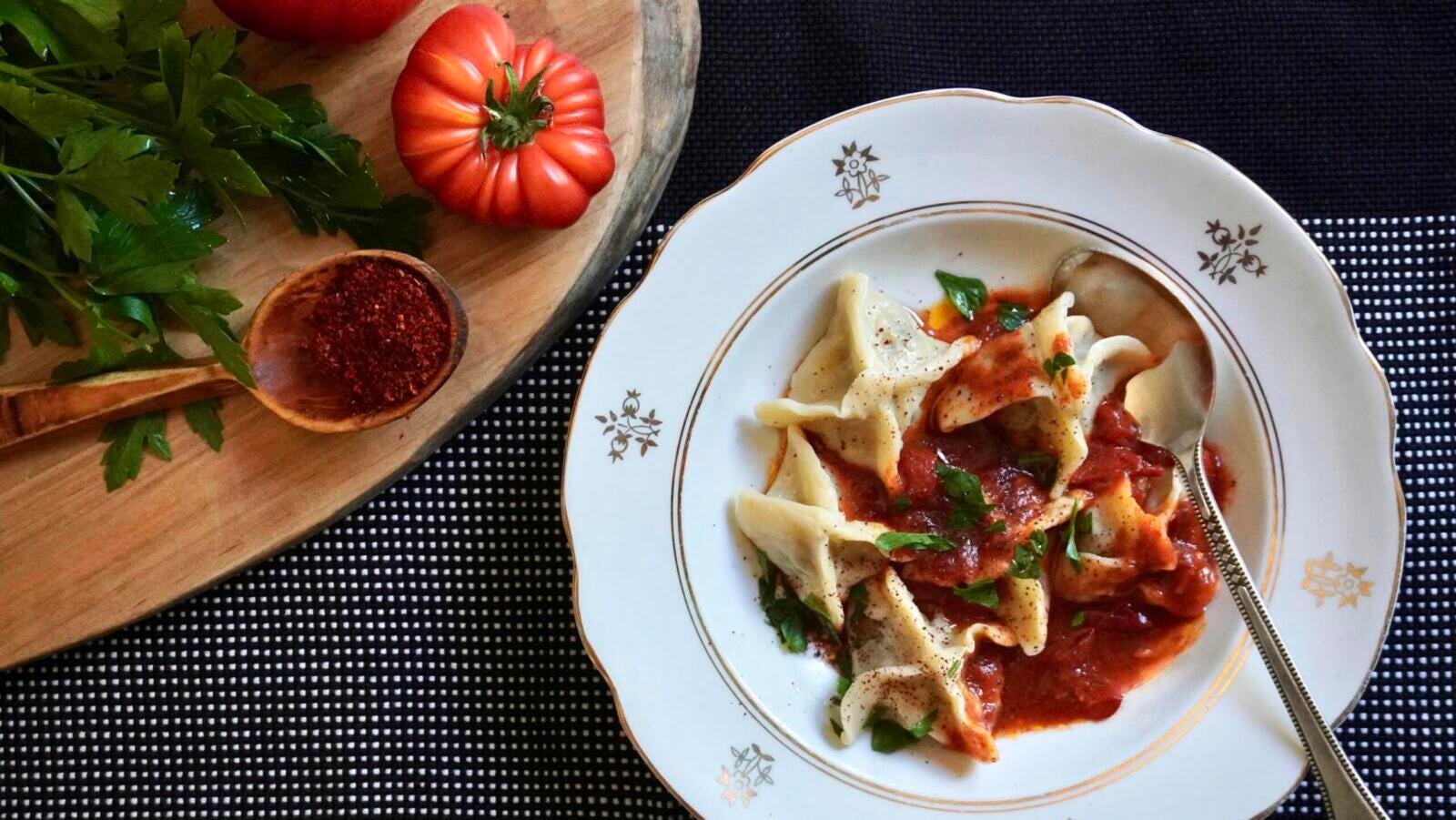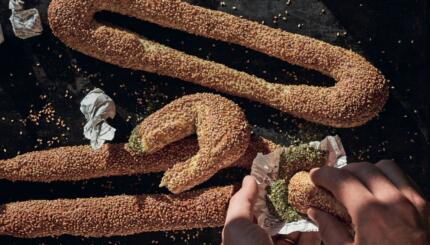From Turkey to Armenia, Uzbekistan to Ukraine, manti are a popular comfort food found in Jewish and non-Jewish communities across Central Asia and Eastern Europe. As an ancient form of dumpling, some trace manti’s origins back to the 1300s during the Mongol Empire in Turkey, while others credit the dish as a gift of the Silk Road; notably, Uyghurs from Northwest China have been making a version of bread prepared in steam known as “mantau” for centuries. Regardless of their origin, manti traveled East toward Korea, West towards the Caucuses and everywhere in between.
While their popularity spans continents, their shapes and styles differ by region. In Turkey they’re often formed into small pyramid-like pouches, sometimes baked and simmered, sometimes boiled, often topped with yogurt, and served in a tomato-based broth or sauce. On the other hand, the ancient Bukharian Jewish community in Central Asia are known for large intricately shaped manti, generously filled with meat and always steamed — never boiled. There’s also a dairy version of Bukharian manti that’s filled with cheese and served with yogurt.

Like many celebratory old-world foods, these hand-formed dumplings take a bit of time and effort to prepare, making them ideal for calling a helping hand into the kitchen. Historically, this dish was even a communal activity. While making homemade dumpling dough can be deeply satisfying, you can simplify the manti-making process by using store-bought wonton wrappers – a tip I happily discovered in Gabrielle Hamilton’s “Prune” cookbook. Given the labor, whether it’s with store-bought or homemade wrappers, when I make manti I often double the recipe, freezing extras for future enjoyment.
Let me preemptively warn you, this manti recipe may not look or taste like the manti you’re familiar with. After exploring different shapes, sizes and toppings, my preference is for smaller-sized manti shaped into pouches. I serve mine in a Turkic-inspired brothy tomato sauce topped with fresh herbs and a sprinkle of lemony sumac; the sweet and sour savoriness of the caramelized tomato complements the heartiness of the delicate beef-filled manti. I’ve provided directions for steaming or boiling your manti, depending on your preferred technique. If you find yourself hoping for a larger-sized manti, the dough can be filled and shaped according to your family’s custom. Whether you stick to the recipe as written or try something more traditional to you, the joy of manti lies not in their size or shape, but in their pillowy soft tenderness, and the inherent comfort they bring to every table.
The Nosher celebrates the traditions and recipes that have brought Jews together for centuries. Donate today to keep The Nosher's stories and recipes accessible to all.

Notes:
- This recipe makes 48 dumplings.
- I use Diamond brand kosher salt for this recipe, if using Morton’s or sea salt use ⅓ less.
- The tomato broth (Steps 4-7) can be made several days in advance and reheated as needed.
- You can freeze your shaped manti (homemade or with wonton wrappers) before cooking on a baking sheet. Once the manti are frozen, transfer them to a Ziploc bag or airtight container. They can be cooked from frozen the same way as they are from fresh.

Manti In Tomato Broth
The ultimate comfort food, made from-scratch or with a store-bought, time-saving hack.
- Total Time: 1 hour minutes-1 hour 45 minutes
- Yield: Serves 4-6
Ingredients
- 3 cups (380 g) all-purpose flour
- 1 ½ tsp Diamond Crystal brand kosher salt
- ¾ (175 ml) cup water
- 1 large egg, beaten
- 50 (3-inch) square wonton wrappers
- 1 lb ground beef or lamb
- 1 small onion, grated or very finely diced
- ½ cup parsley, chopped
- 2 ¼ tsp Diamond Crystal brand kosher salt
- 1 tsp sweet paprika
- ¼ cup olive oil
- 4 cloves garlic, minced
- 1 (6 oz) can (⅔ cup) tomato paste
- 2 large Beefsteak tomatoes, or 4 large Roma tomatoes, diced
- 2 tsp sweet paprika
- ½ tsp red pepper flakes or Aleppo pepper, or to taste
- 4 cups chicken or beef stock
- 1 Tbsp sherry vinegar or red wine vinegar
- salt and pepper, to taste
- chopped parsley, mint, or cilantro
- sumac or Aleppo pepper
- extra-virgin olive oil
Instructions
- For homemade dough: Add the flour and salt to a large bowl and stir together. If you are measuring your flour by cup instead of by weight, remove ¼ cup of flour and reserve.
- Make a well in the center of the flour, and add the water and egg. Stir to combine into a shaggy ball, then transfer onto a clean surface and knead. If the dough feels too sticky, add a little more flour 1 tablespoon at a time. Knead until smooth and elastic, about 8-10 minutes.
- Cover the dough with a bowl, and allow it to rest for 30 minutes. While your dough is resting, prepare your tomato broth.
- For the tomato broth: In a deep skillet or large pot, add the olive oil over medium heat. Once hot add the minced garlic and sauté until just fragrant, about 1 minute.
- Add the tomato paste to the skillet, and stir and sauté for about 4-5 minutes. The tomato paste will turn a darker color as it caramelizes, which will add depth of flavor to the broth.
- Add the diced fresh tomato, paprika, red pepper flakes, salt and pepper, and sauté and stir for 1 minute.
- Add the broth, and let it come to a boil, then gently simmer for 30 minutes. Once it’s done simmering, taste, and adjust the seasoning if needed. Turn off the heat and reserve for serving. If you want a thicker consistency, simmer for longer; if you want a brothier consistency, add more stock or water.
- For the filling: To a medium bowl, add the ground beef, grated onion, chopped parsley, salt and paprika. Mix until just combined; be careful not to overwork the filling or it can become tough.
- To assemble and cook the manti with homemade dough: Line a baking sheet with parchment paper and sprinkle flour on top of the paper. Fill a small bowl with water.
- Lightly flour your surface. Divide the dough into four equal parts. Take one quarter to roll out, and make sure the remaining dough is covered so that it doesn’t dry out.
- Roll out the dough into a thin 11-12-inch square, about as thin as a sheet of lasagna. Cut the dough into 12 even squares, each will be about 2½-3 inches.
- Add 1½ tsp of the filling to the center of each square. Dab a little water along the edges, then bring two opposite corners towards the center of the dough, and then bring the remaining two corners towards the center. Pinch down the edges of the dough, to form a pyramid shape. Alternatively, you can shape the manti however is most desirable or easiest for you. Make sure the edges are very secure, then place the formed manti onto the floured baking sheet. Repeat the manti-forming process with the remaining dough. At this point you can immediately cook (boil or steam) your manti, or you can place the baking sheet into the freezer.
- To boil: Fill a large pot with water and bring to a boil. Add 20-30 manti to the pot, depending on their size. Be careful not to overcrowd the pot; you will likely need to cook them in batches. Cook until they all float to the top and are tender and cooked through, about 5-6 minutes. If cooking from frozen this may take an additional 3-4 minutes.
- To steam: Use a multi-tiered steamer or add water to the bottom of a large pot with a steamer basket placed above the water line. Lightly brush the bottom of the steamer basket with oil, bring the water up to a simmer then place the manti in a single layer into the basket and cover with a lid; if you do not have a multi-tiered steamer you will need to cook them in batches. Steam for 30-40 minutes or until tender and cooked through.
- Serve immediately, topped with a ladle full of hot brothy tomato sauce. Garnish with chopped fresh herbs, a drizzle of olive oil, and a sprinkle of sumac or Aleppo pepper if desired.
- To assemble and steam the manti with wonton wrappers: Line a baking sheet with parchment paper. Fill a small bowl with water.
- Place 6 wonton squares onto a clean surface, keep the remaining squares covered so that they don’t dry out.
- Add 1½ tsp of the filling to the center of each square. Dab a little water along the edges, then bring two opposite corners towards the center of the dough, and then bring the remaining two corners towards the center. Pinch down the edges of the dough, to form a pyramid shape. Make sure the edges are very secure, then place the formed dumplings onto the lined baking sheet. Repeat the dumpling forming process with the remaining wrappers, six at a time. At this point you can immediately cook your manti, or you can place the baking sheet into the freezer.
- Steam your manti using a multi-tiered steamer, or add water to the bottom of a large pot with a steamer basket placed above the water line. Lightly brush the bottom of the steamer basket with oil, bring the water up to a simmer then place the manti in a single layer into the basket and cover with a lid; if you do not have a multi-tiered steamer you will need to cook them in batches. Steam for 10 minutes until tender and the wrapper becomes soft and translucent; if cooking from frozen you will need to steam for 3-4 additional minutes.
- Serve immediately topped with a ladle full of the hot brothy tomato sauce. Garnish with chopped fresh herbs, a drizzle of olive oil, and a sprinkle of sumac or Aleppo pepper if desired.
Notes
- This recipe makes 48 dumplings.
- I use Diamond brand kosher salt for this recipe, if using Morton’s or sea salt use ⅓ less.
- The tomato broth (Steps 4-7) can be made several days in advance and reheated as needed.
- You can freeze your shaped manti (homemade or with wonton wrappers) before cooking on a baking sheet. Once the manti are frozen, transfer them to a Ziploc bag or airtight container. They can be cooked from frozen the same way as they are from fresh.
- Prep Time: 30 minutes-1 hour 15 minutes
- Cook Time: 30 minutes
- Category: Appetizer
- Method: Stovetop
- Cuisine: Jewish




I’m hoping you’ll answer this. By the time holidays come around, good fresh tomatoes are no longer in season and we all know that grocery store tomatoes can hardly be called tomatoes. What do we use instead, crushed-by-hand Sam Marzano plum tomatoes plus juice? diced tomatoes, etc?
Hi Dave, diced tomatoes are best.
If I choose to use the wontons that are frozen, they will be defrosted then filled then refrozen is that a problem Ref freezing the dough? Also, I would love to hear an answer to the other comment that was posted in September below thank you.
Diced tomatoes would work, and no, it is not recommended to refreeze uncooked dough.